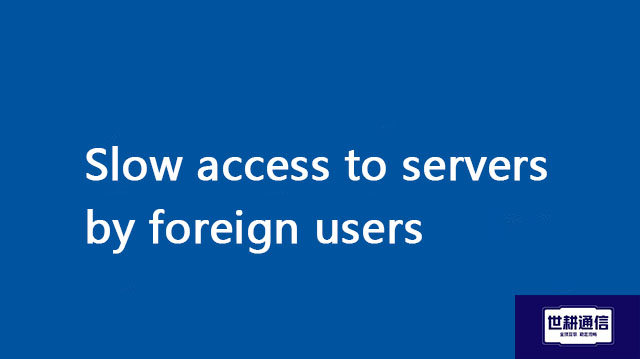Slow access to servers by foreign users//Global IPLC service provider of Shigeng Communication
一、With the acceleration of enterprise globalization, more and more companies need to provide services to global users. However, when servers are deployed domestically and users are distributed overseas, foreign users often face the problem of slow server access speed. This not only reduces user experience, but may also have a negative impact on the company's international business expansion. This article will delve into the causes of this issue and provide a series of effective solutions to help businesses improve the global access performance of their servers. (Click on the link for more content)
Analysis of the causes of the problem
Network latency caused by geographical distance:
When foreign users access domestic servers, data must be transmitted over long distances, which naturally increases network latency.
High latency can lead to slow webpage loading, video playback lag, and delayed application response.
International network bandwidth restrictions:
International network bandwidth resources are limited, and when a large number of overseas users access domestic servers simultaneously, it is easy to cause network congestion.
Network congestion further exacerbates latency, reduces access speed, and overall network stability.
Insufficient network routing optimization:
During the transmission process, data may pass through multiple network nodes. If the routing selection is not reasonable, it can cause the data transmission path to be too long and increase latency.
Improper routing selection may also increase the probability of packet loss and affect the quality of data transmission.
Server performance bottleneck:
If the processing capacity or bandwidth resources of the server are insufficient to cope with a large number of concurrent requests, it will result in longer response times.
Server performance bottlenecks may also cause service interruptions or system crashes, seriously damaging user experience.
Detailed solution explanation
Deploy Content Delivery Network (CDN):
Principle: CDN caches website content closer to users by deploying server nodes globally.
Advantage: Overseas users can obtain content by accessing the nearest CDN node, significantly reducing network latency and improving access speed.
Suggestion: Choose a CDN with extensive global coverage and high reliability.
Optimize network routing:
Using BGP optimization: By optimizing through the Border Gateway Protocol (BGP), selecting a better data transmission path effectively reduces network latency.
Improve server performance:
Increase server resources: Increase the CPU, memory, and bandwidth resources of the server according to business needs, enhance processing capabilities, and support concurrent requests.
Adopting load balancing: Through load balancing technology, requests are distributed to multiple servers, reducing the pressure on individual servers and improving overall system performance.
Use international dedicated line connection:
Principle: Using international dedicated lines such as MPLS dedicated lines or Ethernet dedicated lines to provide high-speed, stable, and secure data transmission.
Advantages: The leased line connection avoids the congestion and instability of the public Internet, and ensures the reliability and consistency of data transmission.
Optimize website and application performance:
Content compression: Compressing website content to reduce data transmission and speed up loading.
Code optimization: Optimize the code of websites and applications, reduce unnecessary requests and processing, and improve response speed and efficiency.
Optimize website and application performance:
Content compression: Compressing website content to reduce data transmission and speed up loading.
Code optimization: Optimize the code of websites and applications, reduce unnecessary requests and processing, and improve response speed and efficiency.
Edge computing technology:
Principle: Deploy computing and processing capabilities to edge nodes closer to users, reducing data transmission and processing latency.
Advantages: edge computing significantly improves the response speed and performance of applications, and greatly improves the user experience.
conclusion
The problem of slow server access speed for foreign users is usually caused by factors such as geographical distance, network bandwidth limitations, insufficient network routing optimization, and server performance bottlenecks. By implementing CDN, optimizing network routing, improving server performance, using dedicated line connections, optimizing websites and applications, and using edge computing and other solutions, enterprises can effectively enhance the access experience of foreign users and enhance the competitiveness of global businesses.

二、Shigeng Communication Global Office Network Products:
The global office network product of Shigeng Communication is a high-quality product developed by the company for Chinese and foreign enterprise customers to access the application data transmission internet of overseas enterprises by making full use of its own network coverage and network management advantages.
Features of Global Application Network Products for Multinational Enterprises:
1. Quickly access global Internet cloud platform resources
2. Stable and low latency global cloud based video conferencing
3. Convenient and fast use of Internet resource sharing cloud platform (OA/ERP/cloud storage and other applications
Product tariff:
Global office network expenses | Monthly rent payment/yuan | Annual payment/yuan | Remarks |
Quality Package 1 | 1000 | 10800 | Free testing experience for 7 days |
Quality Package 2 | 1500 | 14400 | Free testing experience for 7 days |
Dedicated line package | 2400 | 19200 | Free testing experience for 7 days |







